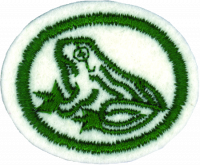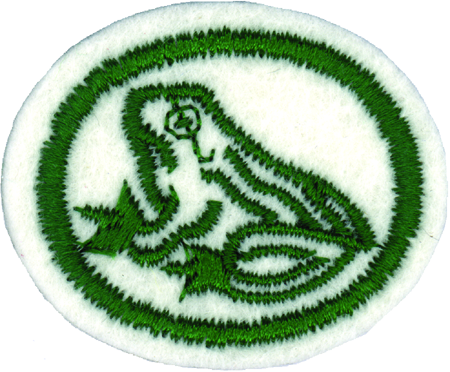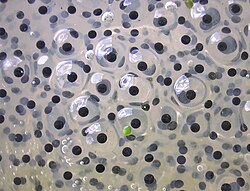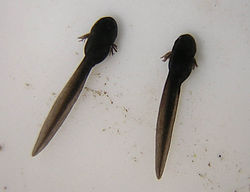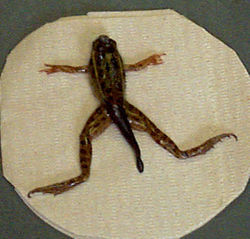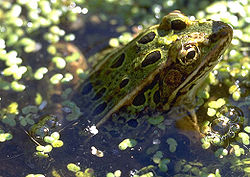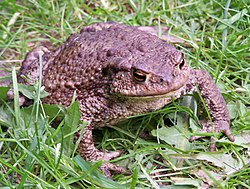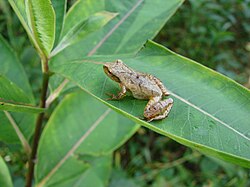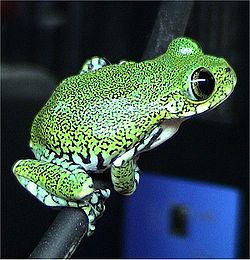Відповіді для Hагорода AM Земноводні
1
Земноводні належать до холоднокровних тварин. Земноводні, або амфібії, у дорослому стані здебільшого поширені на суходолі, проте їхнє розмноження і розвиток відбуваються у воді. Шкіра земноводних гола, позбавлена рогових або кісткових лусок, багата на слизові залози, секрет яких (слиз) забезпечує зволоження поверхні тіла і захист від проникнення хвороботворних мікроорганізмів та нападу хижаків. Дихають земноводні за допомогою легенів та через шкіру. Мають трикамерне серце та два кола кровообігу.
2
Земноводні нараховують близько 4 000 сучасних видів (в Україні - 17), які об'єднані у три ряди; ми розглянемо два з них - Хвостаті та Безхвості амфібії.
Представникам ряду Безхвості (жаби і ропухи) характерні довгі задні лапи, коротке тіло, перетинчасті пальці, витріщені очі та відсутність хвоста. Більшість із них ведуть напівводяний спосіб життя, але легко пересуваються по суші, стрибаючи чи лізучи. Зазвичай вони відкладають яйця в калюжі, ставку або озері; а їхні личинки, звані пуголовками, мають зябра і розвиваються у воді.
Представники ряду Хвостаті мають струнке тіло, короткі лапи та довгий хвіст. Волога шкіра земноводних дозволяє їм мешкати біля водойми або у вологому середовищі під деяким захистом. Деякі види живуть у воді протягом усього життя, інші періодично виходять з води. Є й такі, що у дорослому стані повністю наземні. Саламандри зовні нагадують ящірок, але їх легко відрізнити за відсутністю луски. Вони здатні регенерувати втрачені кінцівки.
3
Використання загальних назв «жаба» та «ропуха» не має таксономічного обґрунтування. З таксономічної точки зору всі представники ряду Безхвості є жабами, але тільки представники сімейства Bufonidae вважаються справжніми жабами. Використання терміну «жаба» у загальних назвах зазвичай відноситься до водних або напівводних видів з гладкою або вологою шкірою, а термін «ропуха» зазвичай відноситься до видів, які мають тенденцію бути наземними із сухою, бородавчастою шкірою. Виняток становить вогнебрюха жаба (Bombina bombina): хоча її шкіра злегка бородавчаста, вона віддає перевагу водному середовищу проживання.
4
Першочерговим захистом для земноводних служить їх здатність бути не помітними для потенційного хижака. Невеликий розмір і забарвлення багатьох видів допомагають у цьому відношенні. Але іноді, замість того, щоб зливатися з навколишнім середовищем, жаби мають дуже яскраве забарвлення. Забарвлення в даному випадку служить попередженням, адже ці жаби отруйні.
Багато жаб виділяють слабкі токсини, які роблять їх неприємними для потенційних хижаків. Наприклад, у всіх ропух є великі отруйні привушні залози, розташовані за очима на маківці. Деякі види жаб особливо токсичні.
Саламандри мають здатність довільно від’єднувати хвости. Коли хижак хапає саламандру за хвіст, вона відкидає хвоста і втікає. Хвіст з часом відростає.
5
Lesser Siren (Template:Localize wikipedia/uk)
Where found: The Lesser Siren is found in the United States, primarily from Virginia to Florida, and west to Texas (ranging into northeastern Mexico as far as Vera Cruz), and north to Illinois, Indiana and Michigan.
Опис: The Lesser Siren appears distinctly eel-like, with an elongated body, 7-26 inches (18-68 cm) in length. They have a pair of greatly reduced front legs, but no back legs. Their head is flattened and blunt with feather-like external gills on each side. They vary in color, from olive green to black, sometimes with darker colored speckling. The Lesser Siren is nocturnal, spending its days hidden in the debris and mud at the bottom of slow moving bodies of water. They feed primarily on aquatic invertebrates, including various kinds of worms, snails, and crustaceans. They will also eat the tadpoles and eggs of other amphibians.
Northern Dwarf Siren (Template:Localize wikipedia/uk)
Where found: South-eastern United States
Опис: The Northern Dwarf Sirenis a salamander lacking hind legs. It retains its gills into adulthood.
Cane toad or Marine toad (Template:Localize wikipedia/uk)
Опис: A large, terrestrial true toad which is native to Central and South America, but has been introduced to various islands throughout Oceania and the Caribbean as well as northern Australia. Adults average 10–15 cm (3.9–5.9 in) in length; the largest recorded specimen weighed 2.65 kg (5.8 lb) with a length of 38 cm (15 in) from snout to vent. The species derives its common name from its use against the cane beetle (Dermolepida albohirtum).
Habitat: The cane toad inhabits open grassland and woodland, and has displayed a "distinct preference" for areas that have been modified by humans, such as gardens and drainage ditches. In their native habitats, the toads can be found in subtropical forests.
Type of sexual reproduction: The cane toad is a prolific breeder; females lay single-clump spawns with thousands of eggs.
Eating habits: Its reproductive success is partly because of opportunistic feeding: it has a diet, unusual among anurans, of both dead and living matter. Most frogs identify prey by movement, and vision appears to be the primary method by which the cane toad detects prey; however, the cane toad can also locate food using its sense of smell. They eat a wide range of material; in addition to the normal prey of small rodents, reptiles, other amphibians, birds and a range of invertebrates, they also eat plants, dog food and household refuse.
Diseases and harm to humans: The cane toad has poison glands, and the tadpoles are highly toxic to most animals (including livestock) if ingested. There have even been human deaths due to the consumption of cane toads. The cane toad is now considered a pest and an invasive species in many of its introduced regions; of particular concern is its toxic skin, which kills many animals—native predators and otherwise—when ingested. This is a big problem in areas where it has been introduced as local animals are not aware of the danger it poses them.
Prevention: Because of its voracious appetite, the cane toad has been introduced to many regions of the Pacific and the Caribbean islands as a method of agricultural pest control. The cane toad does have its uses including in drugs, as leather, and for scientific research. Florida Fish and Wildlife Conservation Commission recommends residents kill them.
Egyptian toad or African common toad (Template:Localize wikipedia/uk)
Опис: The most common frog or toad in Egypt, and across much of Africa. The African common toad is a large sturdy toad with a warty skin. Males grow to a snout-to-vent length of 62 to 91 mm (2.4 to 3.6 in) and females reach 70 to 130 mm (2.8 to 5.1 in). The paratoid glands are large and either parallel or kidney-shaped and the male has a single vocal sac under the chin. The dorsal surface is dark olive-brown with dark patches on the back, often arranged fairly symmetrically, and in younger animals, there is a paler band along the spine. There are smaller dark blotches on the upper lip and the eyelids, and the warts on the flanks are often separated by dark markings. The throats of males are black and the underparts of both sexes are white to beige. The call is a rattling sound made up of two pulses and lasting for about 0.9 second.
Habitat: both moist and dry savanna, montane grassland, forest margins, and agricultural habitats. It is often found near rivers, where it also breeds. It is not a forest species but in the forest zone it can still be found in degraded habitats and towns (including gardens).
Type of sexual reproduction: lays eggs
Eating habits: bugs etc
Diseases and harm to humans: None really, toads are helpful to humans in general, but an overabundance of frogs made life hard for the Egyptians just before the Exodus.
Prevention: N/A.
6
Frogs
The life cycle of frogs, like that of other amphibians, consists of four main stages: egg, tadpole, metamorphosis and adult. The reliance of frogs on an aquatic environment for the egg and tadpole stages gives rise to a variety of breeding behaviors that include the well-known mating calls used by the males of most species to attract females to the bodies of water that they have chosen for breeding. Some frogs also look after their eggs—and in some cases even the tadpoles—for some time after laying.
The life cycle of a frog starts with an egg. Eggs are generally laid in water, and an individual female may lay egg masses containing thousands of eggs. While the length of the egg stage depends on the species and environmental conditions, aquatic eggs generally hatch within one week.
Some frogs do not have the tadpole stage going from egg to adult shape e.g. New Zealand's native frogs (pepeketua) belong to the genus Leiopelma. Eggs hatch and continue life as tadpoles (occasionally known as polliwogs). Tadpoles are aquatic, lack front and hind legs, and have gills for breathing and tails with fins for swimming. Tadpoles are typically herbivorous, feeding mostly on algae, including diatoms that are filtered from the water through the gills. Some species are carnivorous at the tadpole stage, eating insects, smaller tadpoles and fish. The tadpole stage may be as short as a week, or tadpoles may overwinter and metamorphosis the following year in some species, such as the Midwife toad (Alytes obstetricans) and the Common Spadefoot (Pelobates fuscus).
At the end of the tadpole stage, frogs undergo metamorphosis, in which they transition into adult form. Metamorphosis involves a dramatic transformation of body shape and function, as tadpoles develop hind legs and then front legs, lose their gills and develop lungs. Their intestines shorten as they shift from an herbivorous to a carnivorous diet. The final stage of development from froglet to adult frog involves the loss of the tail.
After metamorphosis, young adults may leave the water and disperse into terrestrial habitats, or continue to live in the aquatic habitat as adults. Almost all species of frogs are carnivores as adults, eating invertebrates such as spiders, insects, snails, and slugs. A few of the larger species may eat prey such as small mammals, fish and smaller frogs. Some frogs use their sticky tongues to catch fast-moving prey, while others capture their prey and force it into their mouths with their hands. However, there are a very few species of frogs that primarily eat plants. Adult frogs are themselves preyed upon by birds, large fish, snakes, otters, foxes, badgers, coatis, and other animals.
7
Amphibians are insect eaters, so they are very valuable for controlling mosquito populations. They are also the preferred dinner for several mammal, bird, fish, and reptile species.
Amphibians are valuable for medical research. They are raised and sold to research institutions.
The larvae of newts and salamanders are sold as fish bait.
Amphibians are closely monitored by ecologists, because they are among the first animals affected by environmental problems such as pollution and the destruction of the ozone layer.
Toxins found in toads have been successfully turned into painkillers and other drugs, including a pregnancy indicator.
8
Toads burrow below the frost line and hibernate for the winter. Plant matter actually generates a bit of heat as it decays, so toads prefer areas with plenty of leaf litter and fallen logs.
9
Here are the calls of three frogs.
| File:Bufo bufo call1.ogg | File:Pseudacris-crucifer-002.ogg | File:Leptopelis vermiculatus call.ogg |
For more frog calls, Smithsonian Folkways Recordings has several frog calls available on CD or for download. You can also search Youtube for frogs that live in your region.
10
Frogs call by passing air through the larynx in the throat. In most calling frogs, the sound is amplified by one or more vocal sacs, membranes of skin under the throat or on the corner of the mouth that bulge out during the amplification of the call.
Some frogs lack vocal sacs, but these species can still produce a loud call. Their mouths are enlarged and dome-shaped, acting as a resonance chamber that amplifies their call. The body of a guitar does much the same thing, having a large hollow section that causes the sound to resonate inside before escaping to the outside atmosphere.
11
- IMPORTANT
- In the 1990's, amphibian populations in the United States and Canada began a precipitous and mysterious decline. Many frogs were discovered in Minnesota with unexplained deformities, including extra limbs, missing limbs, deformed limbs, and missing eyes. As a result, many species of amphibians are now protected by state and federal laws. When observing wild amphibians, it is extremely important that they not be handled. Doing so can spread disease to these creatures, causing further decline. Before venturing out, make sure your Pathfinders understand and appreciate the danger facing amphibians today. Do not allow your group to capture or otherwise harass them, and do not destroy their environment. Rather than pursuing the two options (a and b) listed for this requirement, it may be wiser to substitute an alternate requirement. One possibility is to have your Pathfinders research the amphibian population crash.
11a
(1) Де і коли вони сплять
(2) Коли вони залишають свої домівки в пошуках
(3) З'ясуйте шляхом особистого спостереження або книги, що їдять земноводні, де живуть і хто є їх ворогами
(4) На яку відстань вони можуть стрибати або як швидко вони можуть пересуватися їжі та інші цікаві факти з їхнього життя
11b
According to Field Guide of Amphibian Larvae and Eggs of Minnesota, Wisconsin, and Iowa, a publication of the U.S. Geological Survey (USGS), "State and federal laws protect amphibians from exploitation. Collection permits are required from the appropriate state or federal authorities before capturing, handling, or collecting amphibians."
It is therefore recommended that you not attempt to collect amphibian eggs on your own. You can download this book as a PDF from the page cited above. Even if you do not live in Minnesota, Wisconsin, or Iowa, the species covered in this book may be indigenous to your area.
The USGS publication further states, "To prevent the spread of disease to native populations, any frogs or salamanders you raise should not be released back into the environment. Lab-raised amphibians can be anesthetized and euthanized with benzocaine or tricaine methanesulfonate (MS 222, Green 2001). If you anticipate difficulty complying with this guidance, you should not undertake raising larvae in captivity."
